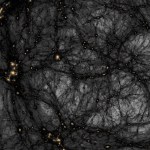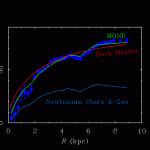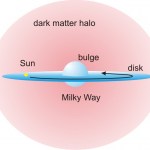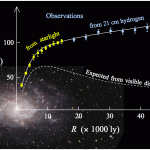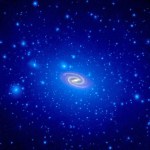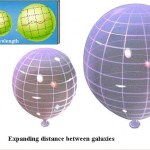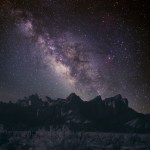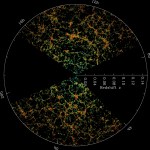Dark Matter
“A cosmic mystery of immense proportions, once seemingly on the verge of solution, has deepened and left astronomers and astrophysicists more baffled than ever. The crux… is that the vast majority of mass of the universe seems to be missing.” -William J. Broad
When we look out at the Universe, the other things we see -- stars, galaxies, and as we're learning, planets -- look an awful lot like the ones right here in our own backyard. Sure, there are subtle differences, but at a macro scale, the Universe appears to look very much like the Universe near and dear to us.
Image credit: ESO / VLT…
When it comes to dark matter, the mysterious substance that makes up the vast majority of the mass in the Universe, there's a whole lot we don't understand or know about it. You might think that there are so many unknowns that are so huge that -- quite reasonably -- perhaps it doesn't exist at all, and there's some other explanation for the behavior of masses on galactic scales and up?
Image credit: NASA/ESA/Richard Massey (California Institute of Technology).
And yet, you can't make that leap unless you've honestly (and scientifically) considered the full suite of evidence and facts…
“I soon became convinced… that all the theorizing would be empty brain exercise and therefore a waste of time unless one first ascertained what the population of the universe really consists of.” -Fritz Zwicky
When we look out at the galaxies in the Universe, watching how they rotate, we find that the starlight we see is woefully insufficient to explain why the galaxies move as they do. In fact, even if we add in the gas, dust, and all the known matter, it doesn't add up.
Image credit: Stefania.deluca of Wikimedia Commons.
Normally, we talk about dark matter as the only viable solution,…
“The privilege of a lifetime is being who you are.” -Joseph Campbell
When you think about dark matter, you probably think of a few things: how mass and gravity don't appear to line up, how there isn't enough normal matter to account for the motions we see on scales of galaxies and up, and how it's necessary to form the structure we see on the largest scales, from the early times of the cosmic microwave background to the cosmic web spanning billions of light years we see today.
Image credit: Tony Hallas, via http://www.qsimaging.com/gallery.html.
But what you might not realize is that…
When you think of the Hubble Space Telescope, perhaps you think of what's touted as its most major feat of all: peering off into deep, dark space, collecting light, and discovering the plethora of distant galaxies laying billions of light years beyond our own.
The Hubble Space Telescope’s Ultra Deep Field. Prior to the Fronier Fields program, this was the deepest look into the Universe available to human kind. Credit: NASA, ESA, H. Teplitz, M. Rafelski (IPAC/Caltech), A. Koekemoer (STScI), R. Windhorst (Arizona State University), and Z. Levay (STScI).
It's a spectacular sight and a…
When you think of dark matter, you very likely think of a halo of diffuse, unseen mass whose gravitational influence is felt by everything within our galaxy, and every galaxy or cluster out there.
Our Milky Way, like most galaxies, is surrounded by an approximately spherical halo of dark matter. Our sun moves through this halo.
But what you might not consider is that this dark matter is consistently passing through Earth and every atom-and-molecule on it. Every once in a while, a lucky (or unlucky) dark matter particle strikes, say, a DNA molecule in your body, breaking its bonds…
“The discrepancy between what was expected and what has been observed has grown over the years, and we’re straining harder and harder to fill the gap.” -Jeremiah Ostriker
If you look at the stars in a galaxy -- and then at all the different wavelengths of light that there are -- you'd think you can do a good job of reconstructing its mass, and where it's located.
Image credit: Multiwavelength images of M31, via the Planck mission team; ESA / NASA.
Makes sense, right? Only then, if you take those observations and compare them to how the stars within the galaxy actually move, you'd be…
“I think if I had to choose, I would rather have gravity instead of zero gravity. It’s fun for a while, but I’d rather live on Earth.” -Kevin A. Ford
By now, you've probably had a lot of opportunities to think about what holds our Universe together: the incredible force of gravitation. Although it's the weakest known force in the Universe, there seems to be no limit to how much mass you can collect in one place. And so on the largest scales -- like solar systems, stars and galaxies -- it seems to be the only force that matters.
Image credit: © 1998–2015 Lynette R. Cook.
Yet the matter that…
“People are trapped in history and history is trapped in them.” -James A. Baldwin
We've come a long way since we first started watching the night skies. Even just a century ago, we thought our Universe was governed by Newtonian gravity and consisted only of our Milky Way and the stars inside.
Image credit: SDSS.
In the past 100 years, we've come to understand that our Universe is a vast, expanding-and-cooling space that formed planets, stars, galaxies and clusters from a past that was so hot and dense we didn't even have atoms, nuclei, or stable protons! There are a myriad of…
“It is always the simple that produces the marvelous.” -Amelia Barr
All things being equal, the simplest explanation is usually the best. At least, that's how Occam's razor is most commonly phrased these days. Yet, when it comes to the headlines -- whether it's a "discovery" of dark matter or "evidence" for life on Mars -- you have to wonder what "simple" actually means.
Image credit: NASA / JPL-Caltech / SAM-GSFC / Univ. of Michigan.
The answer isn't what most people suspect, and it shouldn't really be up for debate. If you want to hypothesize that something novel is occurring, something…
“We are incredibly heedless in the formation of our beliefs, but find ourselves filled with an illicit passion for them when anyone proposed to rob us of their companionship.” -James Harvey Robinson
The Universe seems to be full of contradictions. On one hand, everywhere we look -- in all directions and at all locations -- we find that it's full of stars, galaxies and clusters. There are regions pretty much everywhere where, in the great cosmic struggle between all the pulls and pushes, gravitation has won.
Image credit: NASA; ESA; G. Illingworth, UCO/Lick Observatory and the University of…
“Time takes it all whether you want it to or not, time takes it all. Time bares it away, and in the end there is only darkness.” -Stephen King
This story seems to come up every few months. Someone detects a possibly unexpected signal somewhere in the sky -- normally correlated to the centers of galaxies or galaxy clusters -- and says: that's it, I found dark matter!
Image credit: European Space Agency, NASA and Jean-Paul Kneib (Observatoire Midi-Pyrénées, France/Caltech, USA), via http://www.spacetelescope.org/images/heic0309a/.
Did you, though? The evidence has panned out to be a…
“A single day is enough to make us a little larger or, another time, a little smaller.” -Paul Klee
As the time passes for us all, and we age, so too does everything else in the Universe. For an object like a black hole, it has the potential to form, grow or shrink as we move forward.
Image credit: Mark Garlick (University of Warwick).
The question, of course, that we might ask is how, and by how much? Is normal (baryonic) matter the only culprit, or can dark matter make a difference for this as well? And if so, under what circumstances, and can it teach us anything about…
“The mind, once expanded to the dimensions of larger ideas, never returns to its original size.” -Oliver Wendell Holmes
But it isn't just your mind that expands as time goes on and you increase your knowledge, but the entire Universe as well. General Relativity, as it turns out, doesn't leave us with much of a choice. If you start with a Universe full of matter and radiation, it's got to expand, otherwise it will collapse in on itself!
Image credit: James N. Imamura of U. of Oregon.
But this expansion has consequences of its own, including the surprising fact that there's not only a…
“When a train goes through a tunnel and it gets dark, you don’t throw away the ticket and jump off. You sit still and trust the engineer.” -Corrie Ten Boom
When you look out into the Universe at distant galaxies, at clusters of galaxies or at the Universe on the largest scales, what you see is the luminous stuff, which is pretty exclusively stars and stellar-related objects.
Image credit: Richard Payne (Arizona Astrophotography), via http://apod.nasa.gov/apod/ap040223.html.
But based on what we know about gravitation on those scales, we know there's got to be much more mass than that…
Whether you've been coming around to Starts With A Bang for years or whether you just discovered us a few weeks ago, chances are you've heard us take on the issue of dark matter -- whether it exists and, if so, what its properties are -- and how we think we know that.
Image credit: CMB pattern for a universe with normal matter only compared do our own, which includes dark matter and dark energy. Generated by Amanda Yoho on the Planck CMB simulator at http://strudel.org.uk/planck/#.
And while every professional in the field has the same information at their disposal, each one pieces it…
Today’s article comes courtesy of Sabine Hossenfelder. Sabine is an assistant professor for high energy physics at Nordita, Stockholm. She writes a blog called Backreaction and tweets as @skdh.
Dark matter is one of the most elusive and puzzling entities in our Universe today. We have plenty of indirect evidence for it, but one of the the "holy grail" questions in physics right now is to figure out exactly what its particle nature truly is.
Image credit: NASA, ESA, and T. Brown and J. Tumlinson (STScI).
It ought to exist in a halo around our galaxy, and if it interacts with normal matter…
“Two qualities are indispensable: first, an intellect that, even in the darkest hour, retains some glimmerings of the inner light which leads to truth; and second, the courage to follow this faint light wherever it may lead.” -Carl von Clausewitz
You've been hanging around here long enough that you know all about dark matter's successes, from the CMB to large-scale-structure to gravitational lensing. On the largest scales in the Universe, there's no alternative that even comes close to working, unless you also include dark matter!
Image credit: Tony Tyson, Greg Kochanski and Ian…
“Science casts a long black shadow back over who we think we are, and where it falls the temperature falls with it. Its touch is chilly and unforgiving.” -Richard K. Morgan
Here on Earth, when we're dealing with normal matter, it's relatively easy to measure the temperature of something. Even if you don't have a thermometer handy, if you can do something like measure the speed/kinetic motion of the particles in there, you can easily figure out what the temperature of a system is.
Image credit: screenshot from Schooltube, of a video by mrcoia (Teacher),L A Webber High School.
But…
"There are things known and there are things unknown, and in between are the doors of perception." -Aldous Huxley
From tiny, laser-light wavelengths to dark skies to dark matter on the largest scales in the Universe, it's been quite a week at the main Starts With A Bang collection over at Medium. New this week, we've talked about:
Is there a limit to Lasers? (for our Ask Ethan series),
Finding darkness (for our Weekend Diversion),
The globular cluster Messier 4 (for Messier Monday),
The Unparalleled Power of Experiment,
The Death of Dark Matter's #1 Competitor, and
The Whole Story on…

